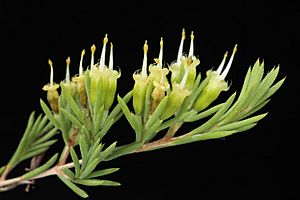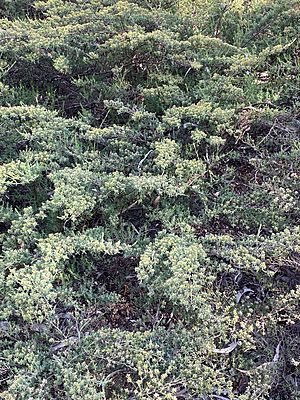Homoranthus melanostictus facts for kids
Quick facts for kids Homoranthus melanostictus |
|
|---|---|
 |
|
| Homoranthus melanostictus in the ANBG | |
| Scientific classification | |
| Genus: |
Homoranthus
|
| Species: |
melanostictus
|
 |
|
| Occurrence data from AVH | |
Homoranthus melanostictus is a plant in the myrtle family Myrtaceae and is endemic to eastern Australia. It has cylinder-shaped to flattened leaves with blackish oil dots and up to six yellow flowers arranged in leaf axils near the ends of the branchlets.
Description
Homoranthus melanostictus may grow to a height 0.25 m (0.8 ft), spreads horizontally and becomes erect at the end of the branches.
Taxonomy and naming
Homoranthus melanostictus was first formally described in 1991 by Lyndley Craven and S.R Jones and the description was published in Australian Systematic Botany. The specific epithet (melanostictus) is derived from the Ancient Greek words melas meaning "black" or "dark" and stiktos meaning "punctured", "dappled" or "spotted".
Distribution and habitat
Widely spread in south-eastern Queensland from north west of Taroom to south of Tara. Grows on sandy soils in shrubby woodland and heath.
Conservation status
A widespread and sometimes common species. Poorly reserved, ROTAP conservation code 3RC using Briggs and Leigh (1996).


